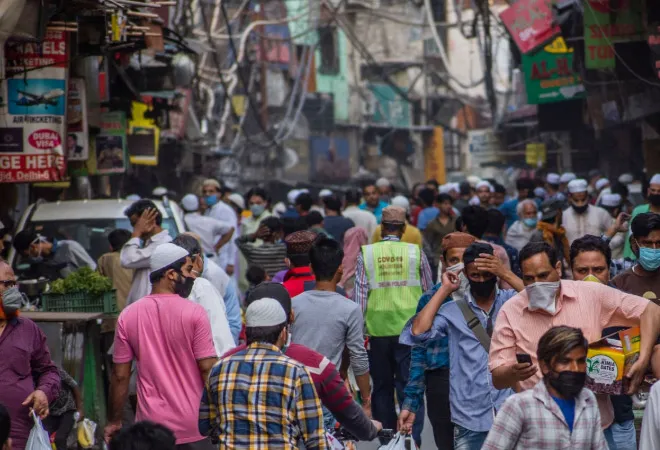
From June 2019, India slowly inched towards an ‘unlock’ phase in managing the COVID-19 pandemic. In August 2020, most restrictions of the lock-down have been relaxed with the central and state governments putting in norms of social distancing — including the usual facemask and maintaining 2-meter distance in public areas. It has been over five months that Prime Minister Narendra Modi announced the total lockdown on 23 March 2020, and yet we see numbers spiralling in several urban pockets of Mumbai, Delhi, Kolkata and many metros.
Anyone visiting the
Lal Kuan Market at New Delhi or the
Dadar flower market in Mumbai in mid-August, could tell that for the people, COVID-19 is now a given and social distancing is out of the window. People who were keen to stick by their traditions of kite flying on Independence Day at Delhi and celebrate the Ganpati festival in Mumbai clearly couldn’t care less.
It is time to redraw the battle lines and deliberate on what measures have to be put in place for tackling crowds in urban public spaces for Indian urban conditions.
These examples lead us to think whether India, in its most dense urban forms, especially in public spaces, can ever follow any universally set rules to win the COVID-19 battle. And if we are not able to follow the rules, or the densities do not allow us to, then how are we going to ever flatten the curve? This calls for a change in the approach of rules set out on social distancing in public spaces.
It is time to redraw the battle lines and deliberate on what measures have to be put in place for tackling crowds in urban public spaces for Indian urban conditions including markets, green open spaces, play areas, station areas, bus stands and depots, which are both realistic and acceptable to people — who are no longer willing to stay under any forced restrictions.
While centralised rules and regulations could help draw out a larger strategy for the nation, when it comes to cities and smaller neighbourhoods, one cannot rely on a ‘one-size-fits-all’ method to resolve the complex issue of overcrowding and social distancing in dense urban environments. It needs a more decentralised, local area approach where a cluster planning could be considered.
One cannot rely on a ‘one-size-fits-all’ method to resolve the complex issue of overcrowding and social distancing in dense urban environments.
Cities are administered through divisions, zones and wards, which could be further decentralised for this purpose to include a cluster of a fixed population. The city ward should ensure that every cluster has defined spaces used by that population. The ward administration could lead this initiative with the help of community volunteers who become champions for the cluster. The existing set ups of citizen volunteering like the Area Locality Management (ALM) in Mumbai and Bhagidari groups in New Delhi could get activated in this system.
Let us look at how this could be done and what it could achieve:
1. Local civic representatives along with citizen volunteers should study the area and draw up the public spaces, including approach roads and footpaths used around the cluster. Markets, open spaces, playgrounds, shopping areas, hospitals will be marked and allocated to every cluster, for the use of that particular population. This could be a passive version of the perimeter controlling approach that the Ministry of Health and Family Welfare had put in place when the nation-wide lockdown had begun.
2. Localised placemaking approaches could be adopted on important roads, and in parks and markets where social distancing norms are implemented through road markings and signages. Simple measures like footpath widening, better pedestrianisation and using barricades and cones for social distancing should be implemented. This could be monitored and followed with the help of volunteers guided by a civic representative from the local ward. Some areas could be declared no-vehicle zones and opened up for pedestrians with adequate diversions. This could mean a spread of population in a wider area.
3. While shops and malls are now open, there could be local norms fixed for clusters on how queues should be formed and markings done to ensure they are followed. Information and signages could be incorporated through the cluster to indicate the norms to be followed on both a personal and collective level. Volunteers could be placed outside shops to support businesses to ensure rules are followed.
4. A digital app could be created for every cluster that will inform citizens of the local area social distancing plan, the available shops, markets and green areas to be accessed. There could be a digital campaign which not only informs people about their local areas, but also ties it up to COVID-19 free living, which could incentivise their participation in the effort. Real time data could indicate areas that are crowded and streets that are already occupied to help people re-route their walks and local travel. This could be further extended to creating localised apps like Singapore’s Trace Together where they have enabled community-driven contact tracing.
5. It will need to be considered that a majority of the population will travel to and from the cluster for work, education or even access other common public spaces — malls, hospitals, etc. These measures will bring in restraint in their behaviour as they will equate local public areas to healthy and safe spaces.
While the cluster approach will look at smaller neighbourhoods with a small population, this method will aim at supplementing the effort being put in by the municipal, state and central governments. It is an integrated response that will be needed if we want to get out of the COVID-19 grid and reimagine spaces that can speed up our recovery.
The views expressed above belong to the author(s). ORF research and analyses now available on Telegram! Click here to access our curated content — blogs, longforms and interviews.



 From June 2019, India slowly inched towards an ‘unlock’ phase in managing the COVID-19 pandemic. In August 2020, most restrictions of the lock-down have been relaxed with the central and state governments putting in norms of social distancing — including the usual facemask and maintaining 2-meter distance in public areas. It has been over five months that Prime Minister Narendra Modi announced the total lockdown on 23 March 2020, and yet we see numbers spiralling in several urban pockets of Mumbai, Delhi, Kolkata and many metros.
Anyone visiting the
From June 2019, India slowly inched towards an ‘unlock’ phase in managing the COVID-19 pandemic. In August 2020, most restrictions of the lock-down have been relaxed with the central and state governments putting in norms of social distancing — including the usual facemask and maintaining 2-meter distance in public areas. It has been over five months that Prime Minister Narendra Modi announced the total lockdown on 23 March 2020, and yet we see numbers spiralling in several urban pockets of Mumbai, Delhi, Kolkata and many metros.
Anyone visiting the  PREV
PREV


